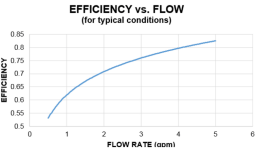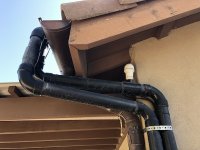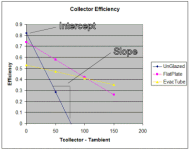But as I posted above, you will always come out ahead with RPM reduction. The loss in heating efficiency is always more than compensated for by an increase in energy efficiency because the energy cost curve is much steeper than the heating efficiency curve so it will always be the case.
Then I've been telling that incorrectly. I understand better now.
I have other considerations that I've been projecting onto others (that they may or may not have). I don't have an energy cost constraint, because of my PV, but I do have a runtime constraint and one other. I imagine others might as well. Mine has to do with available sun. I have eight hours max, so I want my pool to get as warm as possible in that time. I also want my pool to get as warm as it can as
soon as it can, which extends my swimmable hours per day (swimmable as in my preferred comfort level).
Even with my new understanding of the energy cost curve, I would contend that only applies if cost is the primary, or only, consideration. If you cannot extend your runtime to compensate for the lower heating efficiency resulting from reducing RPMs, or if you want your pool to be warmer sooner than later, than I would think running the panels at optimum flow rate would be preferred.
There's another factor, too, though I'm not sure how much it would impact the overall cost of heating a pool. The sun on the water is doing a lot of the work. Maybe as much or more than the panels. My system usually shuts down before the end of my eight hour runtime, at which point the pump ramps down and I'm no longer paying for heating (just SWG). If the heater is working less efficiently, and so taking longer to heat the water, then what the sun adds to the equation will take longer, and so the pump will have to run longer. Does it follow that the sooner the pool can reach the desired temp, the sooner the pump can throttle back, and so the sooner the cost goes down? That might be a bit of a stretch, but I imagine there's something there.
I think where I got stuck is when I refer to optimum, I was more concerned about the max than the minimum. By that I mean: I think you can keep increasing heating efficiency by increasing flow (with more RPM). The more water you move, the warmer your pool will get. But there is a diminishing return: the curve flattens out as it gets to the top, such that increasing RPM become less and less advantageous, compounded by the inverse cost effectiveness of pumping water: the higher the RPMs the more it costs, but logarithmically, as in: 10% more RPMs is considerably more expensive than 10% in cost. Plus there is the physical limit of the plumbing and the solar panels, they can only take so much pressure.
I've always assumed that panel manufacturers find this happy medium for us. My 5GPM/panel gets me the warmest pool possible before the cost of doing a little better is not worth it.
I have it straighter in my head, Mark, than I can explain it, but please correct me if I've strayed.





